How AI Predicts Plant Disease with Genomics
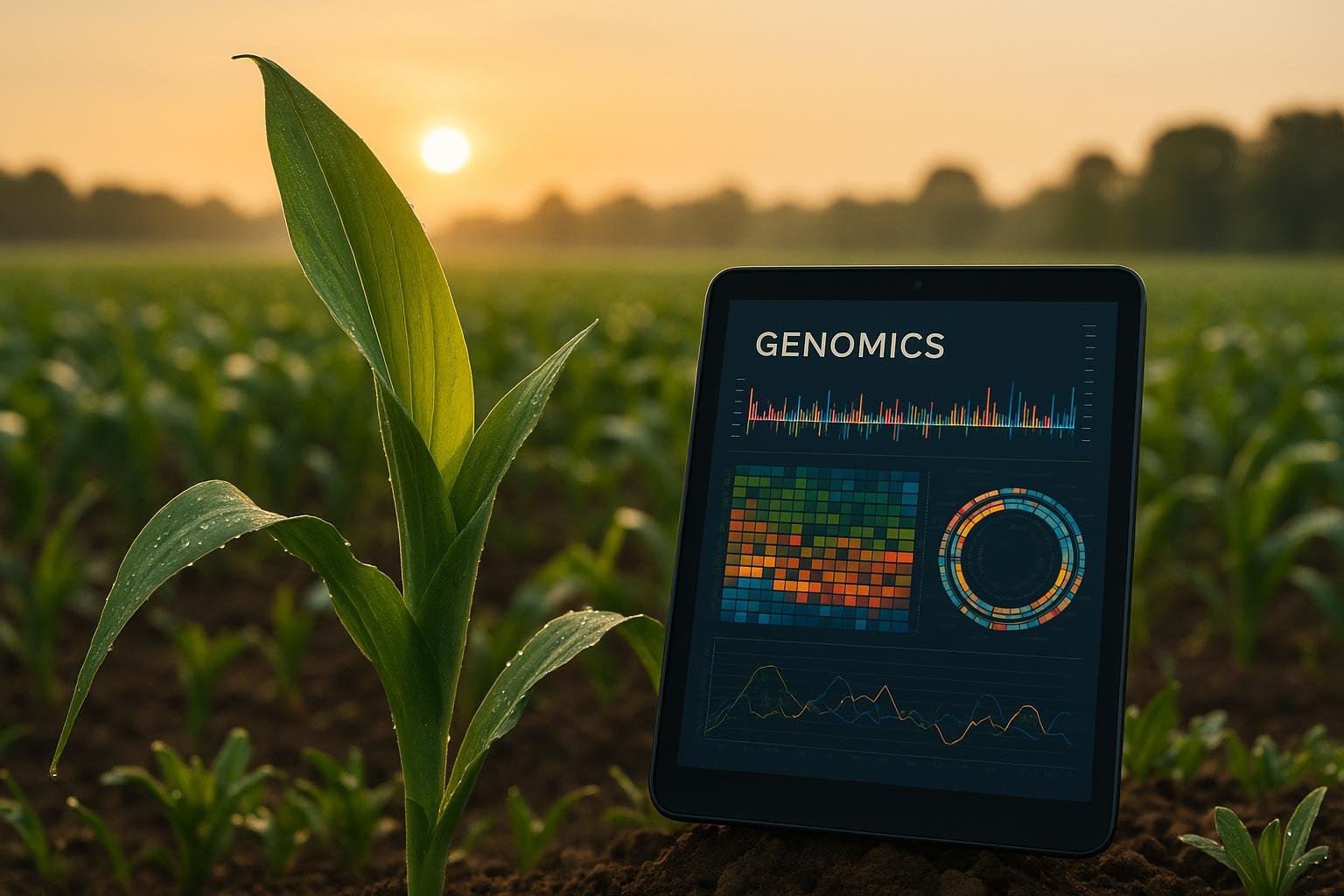
AI is transforming how we detect and manage plant diseases. By analyzing genetic data, these tools identify diseases early - sometimes before visible symptoms appear - and recommend resistant plant varieties. Here's how it works:
- Faster Detection: AI-powered tools reduce disease detection time by up to 80%, delivering results in under 2 minutes with 90–95% accuracy.
- Genomics Integration: Genomic data reveals plant resistance and pathogen vulnerabilities, enabling targeted interventions.
- Advanced AI Models: Machine learning and neural networks process vast datasets, identifying genetic markers linked to disease resistance with up to 95% accuracy.
- Practical Applications: Tools like AIGardenPlanner provide gardeners with tailored advice, reducing reliance on chemical treatments.
AI and genomics are reshaping plant health management, offering smarter, faster, and more precise solutions for farmers and gardeners alike.
How we're using DNA tech to help farmers fight crop diseases | Laura Boykin

How AI Predicts Plant Diseases Using Genomic Data
AI transforms raw genomic data into precise disease predictions through a streamlined, three-step process.
Collecting and Preparing Genomic Data
The process begins with gathering high-quality genomic data. Scientists collect DNA samples from plants grown in varied environments, at different growth stages, and under diverse disease exposure conditions. This ensures a comprehensive dataset that captures genetic variation and plant responses to diseases.
Interestingly, preparing this data accounts for up to 80% of the workload in building AI systems[4]. The preparation process involves several critical steps to ensure the data is ready for machine learning analysis.
First, researchers clean the data by removing missing values, outliers, and inconsistencies that could disrupt the analysis. Any gaps in the dataset are addressed using imputation techniques or by carefully omitting incomplete data points.
Next, the genetic information undergoes transformation to make it suitable for AI processing. This includes converting categorical data, like allele types, into numerical formats and normalizing continuous variables to ensure different measurements can be compared on the same scale.
Additional steps include detecting and removing outliers - samples with unusual genetic traits caused by contamination or sequencing errors - and applying dimensionality reduction techniques like principal component analysis. These methods simplify complex datasets, focusing on the most relevant genetic markers, which speeds up model training and minimizes overfitting risks.
With the data cleaned and prepared, AI can then hone in on the genetic signals that hold the most predictive value.
How AI Identifies Key Genetic Markers
Once the data is prepped, the next challenge is pinpointing which genetic markers are most important. Feature selection algorithms reduce the dataset by isolating the markers with the strongest predictive power[1]. Instead of analyzing every genetic signal, these methods focus on the ones that matter most.
Machine learning excels at identifying complex interactions between genetic markers - patterns often missed by traditional methods. By systematically testing combinations of features, the models rank genetic markers based on their ability to predict disease outcomes.
A compelling example comes from a 2020 study where researchers analyzed a dataset of single-nucleotide polymorphisms (SNPs) from 219 sugarcane plants. Machine learning identified genomic regions associated with resistance to brown rust. The final dataset, narrowed down to 131 SNPs, achieved an impressive 95% prediction accuracy[1]. Many of the identified regions matched previously known genetic markers, showcasing the power of this approach.
Training Models and Making Predictions
The final step involves training machine learning models using the cleaned data and the selected genetic markers. Supervised learning methods teach the AI by providing examples of plants resistant or susceptible to specific diseases, along with their genetic profiles[1]. The dataset is divided into training and test sets, allowing the model to learn from known cases and then be evaluated on unseen data.
Neural networks are particularly effective in this stage, as they can capture complex, non-linear relationships between genetic markers and disease outcomes. These models integrate multidimensional data to generate a single, accurate prediction[1].
Recent studies highlight the effectiveness of these models: 95% accuracy for predicting rice blast, 85% for rice black-streaked dwarf virus, and 85% for rice sheath blight[5]. Plus K models have also demonstrated strong performance, predicting wheat blast and wheat stripe rust with mean accuracies of 90% and 93%, respectively[5].
Once trained, these models can analyze new plant samples, using their genetic markers to predict disease resistance or susceptibility. This capability supports proactive breeding strategies and helps gardeners choose plant varieties that thrive under local disease pressures.
For example, tools like AIGardenPlanner use these genomic predictions to recommend disease-resistant plants tailored to specific regional conditions. By leveraging insights into the genetic basis of disease resistance, gardeners can reduce their reliance on chemical treatments and enjoy healthier, more successful gardens.
Main AI Methods for Genomic Disease Prediction
Building on earlier discussions about data preparation and model training, let’s dive into three key AI techniques that are transforming genomic disease prediction: neural networks, support vector machines (SVMs), and deep learning. Each of these methods brings unique strengths to the table.
Neural Networks for Identifying Patterns
Neural networks are powerful tools for uncovering complex, non-linear relationships between genomic data and plant disease outcomes - patterns that traditional methods often overlook. Convolutional neural networks (CNNs), in particular, stand out for their ability to analyze spatial relationships within genetic data. This works similarly to how CNNs process image pixels, but here, they’re applied to DNA sequences [6].
By encoding genetic variants as artificial image objects (AIOs), CNNs can spot intricate patterns that indicate disease resistance or susceptibility [7]. The process typically involves three major steps: data collection and preprocessing, model selection and training, and validation [1][7]. A noteworthy example is the deep neural network genomic prediction (DNNGP) method, which has outperformed traditional linear regression and other machine-learning models in predicting agronomic traits using multi-omics data [1].
In addition to their flexibility, neural networks can be enhanced with explainable AI (XAI) techniques. This integration helps researchers understand how these models arrive at their predictions, offering valuable insights into the genetic factors influencing disease outcomes [7]. For classification tasks, however, SVMs offer another effective approach.
Support Vector Machines for Classification
Support vector machines (SVMs) are widely used for classifying genetic data. They work by identifying an optimal hyperplane that separates different classes of data, maximizing the margin between them [10]. Their effectiveness is further enhanced by the kernel trick, which allows SVMs to operate in high-dimensional spaces without the need for explicit feature mapping [8].
For instance, in a wheat genotype classification study, the radial basis function (RBF) kernel achieved an impressive 93.2% accuracy. By incorporating weighted accuracy ensemble methods, researchers pushed this further to 94.9% [9]. Advanced optimization techniques, like particle swarm optimization, added another 1.7% gain, reaching the same 94.9% accuracy [9].
SVMs have demonstrated their value across various genomic applications, from identifying differentially expressed genes in diseased versus healthy plant tissues to predicting regulatory elements like promoters and enhancers [8]. Their resilience to noise makes them particularly useful when dealing with real-world genomic data, which often includes measurement errors or missing values. For even more complex analyses, deep learning takes the lead.
Deep Learning for Complex Genomic Data
Deep learning is a game-changer for analyzing intricate genomic datasets. These models excel at integrating diverse types of genomic and environmental data, making them ideal for generating robust predictions. Unlike traditional methods, deep learning models learn features directly from raw data, minimizing the need for manual preprocessing.
This capability is crucial given that 98% of the human genome is non-coding, and 93% of disease-associated variants are found in these non-coding regions. Such complexity requires advanced pattern recognition, which deep learning delivers [11].
A standout example is Google’s DeepVariant, which has significantly improved the accuracy of single-nucleotide variant and insertion-deletion detection. When combined with traditional variant callers like SAMtools and GATK, DeepVariant demonstrated superior performance [13].
Deep learning models often include millions of trainable parameters, enabling them to capture subtle interactions like non-additive and epistatic effects that simpler models might miss [12][2]. To implement deep learning effectively in genomic disease prediction, researchers should focus on:
- Curating large, high-quality training datasets while removing confounders.
- Selecting architectures tailored to the data, such as recurrent or convolutional networks.
- Preventing overfitting through techniques like L2 regularization and dropout.
Metrics like precision and recall are particularly important when working with imbalanced datasets, where disease-resistant plants may be rarer. These insights have practical applications, such as helping platforms like AIGardenPlanner make more accurate plant recommendations based on local disease pressures and genetic resistance profiles.
sbb-itb-4d6a8dd
🚀 Ready to Reinvent Your Garden?
Join thousands of homeowners who have transformed their gardens using our AI design tool. Upload one photo to explore endless possibilities.
Get your AI garden designs →Challenges and Best Practices in AI Plant Genomics
AI holds great potential for predicting plant diseases using genomics, but several hurdles can hinder even the most advanced models. Tackling these challenges with effective strategies is essential to building systems that work reliably in real-world agriculture.
Data Quality and Variety Issues
The effectiveness of genomic AI often depends on the quality of its data. Poor data can severely limit its potential, and it's worth noting that global crop losses average 20–30%, with pathogens reducing yields in India by 35% on average[16].
Problems often arise during data collection. Sequencing errors, incomplete records, and inconsistent sampling methods can create datasets that seem thorough but are riddled with flaws. For instance, noise and mishandling during sample collection can lead to misleading conclusions about a plant's disease resistance. Even expert labeling isn't immune to errors; studies have found that ImageNet's validation dataset contains about 6% incorrect labels[14].
Another common issue in genomic datasets is missing sequencing and measurement data, which can directly affect the accuracy of predictions. Imbalanced datasets are another hurdle, as disease-resistant plants often make up only a small portion of samples.
To improve data reliability, researchers can apply strict quality control measures at every stage. This includes validating sequencing accuracy, calibrating equipment for precise phenotypic measurements, and following standardized protocols like the Minimum Information About Plant Phenotyping Experiment (MIAPPE) guidelines[15]. Techniques such as imputation or removing variables with minimal missing values can also help. Additionally, tools like the Integrated Rule-Oriented Data System (iRODS) can enhance how datasets are organized and retrieved, making them easier to manage and use effectively[15].
Making Models Accurate and Understandable
Creating AI models that are both accurate and easy to interpret is a key challenge in plant genomics. While these models may deliver precise predictions, they often lack transparency, making it hard for farmers and researchers to fully trust the results.
Overfitting is a major concern, especially in plant genomics, where genetic markers (SNPs) far outnumber the available plant samples. Models that perform well on training data may fail when faced with new genetic variations or environmental conditions[1].
A mix of strategies can help address these issues. Explainable AI (XAI) approaches, for example, can make models more transparent. Techniques like SHAP (SHapley Additive exPlanations) pinpoint which genetic markers or signals most influence predictions, while LIME (Local Interpretable Model-Agnostic Explanations) explains why certain genetic profiles lead to specific outcomes[17].
"Employing explainable artificial intelligence algorithms enhances model interpretability, identifying genetic polymorphisms associated with the shelling percentage. These findings underscore XAI's efficacy in predicting phenotypic traits from genomic data, highlighting its significance in optimizing crop production for sustainable agriculture." – Pierfrancesco Novielli et al.[18]
Hybrid models that combine multiple machine learning methods often perform better than single-method approaches. These advanced strategies are helping to improve both prediction accuracy and adaptability.
Ways to Improve Genomic Predictions
New methods are making genomic predictions more scalable and effective while addressing challenges like data integration and collaboration. Federated Learning (FL) is one such approach, allowing farmers and researchers to train AI models locally and share only model updates. This protects sensitive genetic data while enabling collective improvements across different agricultural environments[20][21].
Multi-omics integration is another powerful tool. By combining data from genomics, transcriptomics, proteomics, metabolomics, and phenomics, scientists can gain a more comprehensive understanding of disease resistance. For instance, in rice research, deep neural networks trained on integrated transcriptomic and metabolomic data improved starch trait predictions by over 20% compared to models using single-omics data[17].
Techniques like transfer learning and meta-learning are also proving valuable. These methods help models adapt to different crops and environments, making them especially useful for smaller farms with limited data[19][20].
For practical use, lightweight deep learning models are bringing genomic predictions to farmers with fewer resources. Properly trained convolutional neural networks (CNNs) can achieve 95–99% accuracy in identifying crop diseases. Data augmentation techniques further expand existing datasets, reducing the need for costly new data collection[20][21].
Cloud computing platforms like Amazon Web Services and Google Cloud offer scalable resources for large-scale analyses, while workflow management systems like Nextflow and Snakemake support reproducible research. Open-source frameworks such as OmicsPipe, MOFA+, and DeepMOCCA are specifically designed for integrating multi-omics data and predicting traits[17].
In a notable example, combining genomic analysis with CRISPR-Cas9 and AI-driven selection reduced greening symptoms in citrus by 60% and increased yields by 50%, saving growers an estimated $600–$750 per acre[15].
These advancements highlight AI's growing role in managing plant health. For platforms like AIGardenPlanner, this means offering gardeners more precise recommendations based on local disease risks and genetic resistance, helping them choose the best varieties for their unique conditions.
Uses and Future of AI in Plant Disease Management
AI-driven genomic analysis is reshaping how we manage plant health, shifting the focus from treating diseases after they appear to preventing them before they start. Today’s AI tools already enhance plant health management, and as technology advances, both large-scale farming and home gardening stand to benefit even more. These developments extend the reach of earlier breakthroughs in genomic methods, bringing cutting-edge solutions from research labs into everyday gardens.
AI in Eco-Friendly Agriculture and Gardening
Modern AI systems are opening the door to more sustainable growing practices, making them easier and more effective. By analyzing genomic data, these systems help farmers and gardeners select plant varieties that naturally resist diseases, reducing the need for chemical treatments.
Take John Deere's See & Spray, for example. This tool uses computer vision to distinguish crops from weeds, significantly cutting herbicide use[22]. But the benefits don’t stop there. AI models can now identify plant diseases with impressive precision - like detecting apple scab with 95% accuracy or spotting yellow rust in wheat before visible symptoms appear[22].
For home gardeners, these advancements mean smarter choices in plant care. Instead of relying on broad-spectrum treatments, gardeners can select plants with built-in resistance to local diseases. This not only reduces chemical use but also promotes healthier ecosystems in their gardens.
The economic upside is hard to ignore. Pest infestations currently reduce crop productivity by 30–33% annually[3]. With AI-driven disease prediction, farmers can improve yields and lower input costs. Many report saving on labor and achieving higher crop quality by using AI-powered monitoring systems.
Adding AI Tools to Gardening Platforms
AI-powered tools are increasingly being integrated into gardening platforms, offering tailored advice to users. For instance, AIGardenPlanner uses these innovations to provide personalized recommendations for plant care and disease management. Soon, these platforms could suggest plant varieties based on local genomic data and environmental factors, helping gardeners choose disease-resistant options.
Here’s how it works: platforms analyze local disease data, compare it with plant genomic profiles, and recommend specific varieties. For example, in regions prone to late blight, AI might suggest tomato varieties with genetic resistance markers.
Researchers like Zhu et al. have developed multi-modal AI models to detect potato blight and combined this capability with GPT-4 for interactive guidance[2]. These tools also predict potential disease outbreaks by analyzing weather patterns, soil conditions, and plant genetics, allowing gardeners to take preemptive action.
For professional landscapers, using AI-powered platforms means they can offer plant selections backed by scientific data. This not only enhances their services but also reduces the need for ongoing maintenance.
New Trends in AI-Genomics
Emerging technologies are redefining how we approach plant disease management. Large Language Models (LLMs) are proving to be game-changers in interpreting complex genomic data. For example, AgroNT, an LLM trained on genomes from 48 plant species, outperforms traditional tools in tasks like regulatory annotation and tissue-specific gene expression[23]. It has achieved over 77% accuracy in promoter prediction, helping identify genetic switches that control disease resistance.
Other advancements include integrating GPT-4 with image recognition models like YOLOPC to analyze agricultural images and offer real-time diagnostic guidance. Qing et al. demonstrated 90% accuracy in generating agricultural diagnostic reports using this approach[2]. Similarly, researchers like Nanavaty et al. have combined visual question-answering models with genomic data to improve wheat rust identification, bridging the gap between image analysis and textual insights[2].
Single-cell genomics and spatial transcriptomics are taking plant disease research to the cellular level, mapping gene activity within tissues to reveal how plants respond to pathogens. This level of detail enables more precise interventions and better disease outcome predictions.
CRISPR technology is also advancing functional genomics by allowing researchers to edit specific genes and study their role in disease resistance.
"By identifying genes-of-importance to nitrogen utilization, we can select for or even modify certain genes to enhance nitrogen use efficiency in major US crops like corn." - Gloria Coruzzi, Carroll & Milton Petrie Professor in NYU's Department of Biology and Center for Genomics and Systems Biology[25]
Cloud computing is making these advanced tools more accessible. Farmers and researchers can now use cloud platforms for genomic analysis without investing in costly local infrastructure, leveling the playing field for smaller operations.
These combined technologies are making disease prediction as routine as checking the weather. For instance, YOLOv7 and YOLOv8 architectures, paired with data augmentation techniques, now achieve over 95% precision and 93% recall rates in disease detection tasks[2].
"These models not only were able to accurately predict gene activity from sequences but also pinpoint which sequence parts contribute to these predictions." - Dr. Jedrzej Jakub Szymanski, head of IPK's research group "Network Analysis and Modelling"[24]
For platforms like AIGardenPlanner, these advancements could soon enable real-time disease risk assessments, genetic compatibility checks for companion planting, and personalized breeding suggestions for home gardeners. Together, these innovations are shaping the future of plant health management, benefiting both large-scale agriculture and individual gardeners alike.
Conclusion: Changing Plant Health with AI and Genomics
The combination of AI and genomics is reshaping how we tackle plant disease prediction and management. What used to take weeks can now be accomplished in minutes, thanks to advanced models that decode genetic patterns with impressive accuracy. This progress brings cutting-edge tools directly into the hands of farmers and gardeners, revolutionizing both large-scale farming and home gardening.
Models like YOLOv7 and YOLOv8 now boast precision rates above 95% and recall rates exceeding 93% [2]. These advancements are vital, especially considering the need to boost global food production by 60% by 2050 to meet growing demand [1].
Today’s AI not only identifies diseases but also predicts them before visible symptoms appear. By analyzing genomic data alongside environmental factors, these systems can forecast outbreaks and recommend disease-resistant plant varieties tailored to specific conditions. For example, in India, AI-powered genomic research has pinpointed salt-tolerance genes in rice, leading to varieties capable of thriving in saline coastal regions [27].
Another leap forward comes from integrating large language models with disease detection. Tools like YOLO-GPT merge visual recognition with AI-driven insights, enabling both precise disease identification and actionable recommendations. In 2023, researchers achieved 90% accuracy in generating diagnostic agricultural reports by combining GPT-4 with image recognition models [2].
For home gardeners, platforms like AIGardenPlanner have made these breakthroughs more accessible. By considering location, climate, and local disease patterns, these tools suggest disease-resistant plants and provide detailed care guides. The AI Plant Advisor, for instance, offers tailored advice without requiring users to have any scientific background. These practical applications go hand in hand with larger sustainability benefits.
AI-driven innovations in crop breeding have also had a significant environmental impact. For instance, tools used in rice and wheat breeding have cut water usage by 20% while maintaining or even increasing yields [27]. This is crucial when you consider that over 120 million tonnes (about 132 million tons) of nitrogen fertilizer are applied globally every year, with more than half of it lost to the environment [28].
"Advanced machine learning will help researchers solve the puzzles of plant biology, offering innovations that improve the future of agriculture and human wellbeing." - Brad Jakeman, Founding Managing Partner, Rethink Food
Technology continues to evolve at a rapid pace. Multi-omics approaches now offer a comprehensive view of plant health, while plant-focused large language models are incorporating genomic data from lesser-studied species, broadening our understanding of plant biology and genetics [26].
Whether you're tending a backyard garden or managing a large farm, AI-powered genomic tools are opening up new possibilities. They help prevent diseases before they take hold, guide the selection of optimal plant varieties, and reduce environmental impact. The future of plant health management is here, and it’s more accessible than ever.
FAQs
How does AI make plant disease detection faster and more accurate than traditional methods?
AI is transforming how plant diseases are detected by dramatically improving both speed and accuracy. Using advanced machine learning models like convolutional neural networks (CNNs), AI can achieve precision rates of 95–99% - a level far beyond what traditional visual inspections can offer. On top of that, AI-powered tools can handle massive amounts of data in record time, cutting detection efforts by up to 80% compared to manual methods.
What makes AI even more impressive is its ability to go beyond spotting visible symptoms. It can detect subtle signs of trouble, like changes in a plant's metabolic activity or responses to environmental stress, enabling early disease prediction - often before any physical symptoms are noticeable. This gives farmers and gardeners a crucial head start, allowing them to act quickly to safeguard their crops and maximize harvests.
How does genomic data help AI predict and manage plant diseases?
Genomic data plays a key role in boosting AI's ability to predict and manage plant diseases. By examining genetic information, AI can pinpoint specific genes and traits tied to disease resistance. This allows it to uncover patterns in how plants react to pathogens and environmental conditions.
Through machine learning, AI analyzes the intricate relationships between a plant's genome, pathogens, and even its microbiome. This leads to better disease forecasting, resistance mapping, and the creation of hardier, disease-resistant crops. These advancements speed up breeding programs and make plant disease management more targeted and efficient, promoting more sustainable farming practices.
What challenges does AI face in using genomics to manage plant diseases, and how are they being solved?
AI encounters several obstacles when applied to genomics for managing plant diseases. These include limited availability of high-quality data, the challenges of interpreting complex results, and regulatory barriers. On top of that, training AI models demands large, standardized datasets, which are often tough to gather and organize.
To tackle these challenges, researchers are turning to advanced machine learning techniques like convolutional neural networks, which can boost prediction accuracy. They're also working to improve data quality, build more comprehensive datasets, and make AI systems more transparent and easier to understand. These efforts are paving the way for AI to become a highly effective tool in predicting and managing plant diseases in practical applications.
🎨 Visualize Your Dream Garden Today!
Transform any outdoor space into a professional landscape design in minutes. Just upload a photo, choose your style, and let our AI do the rest.
Start your garden transformation now →Related posts
Related Articles
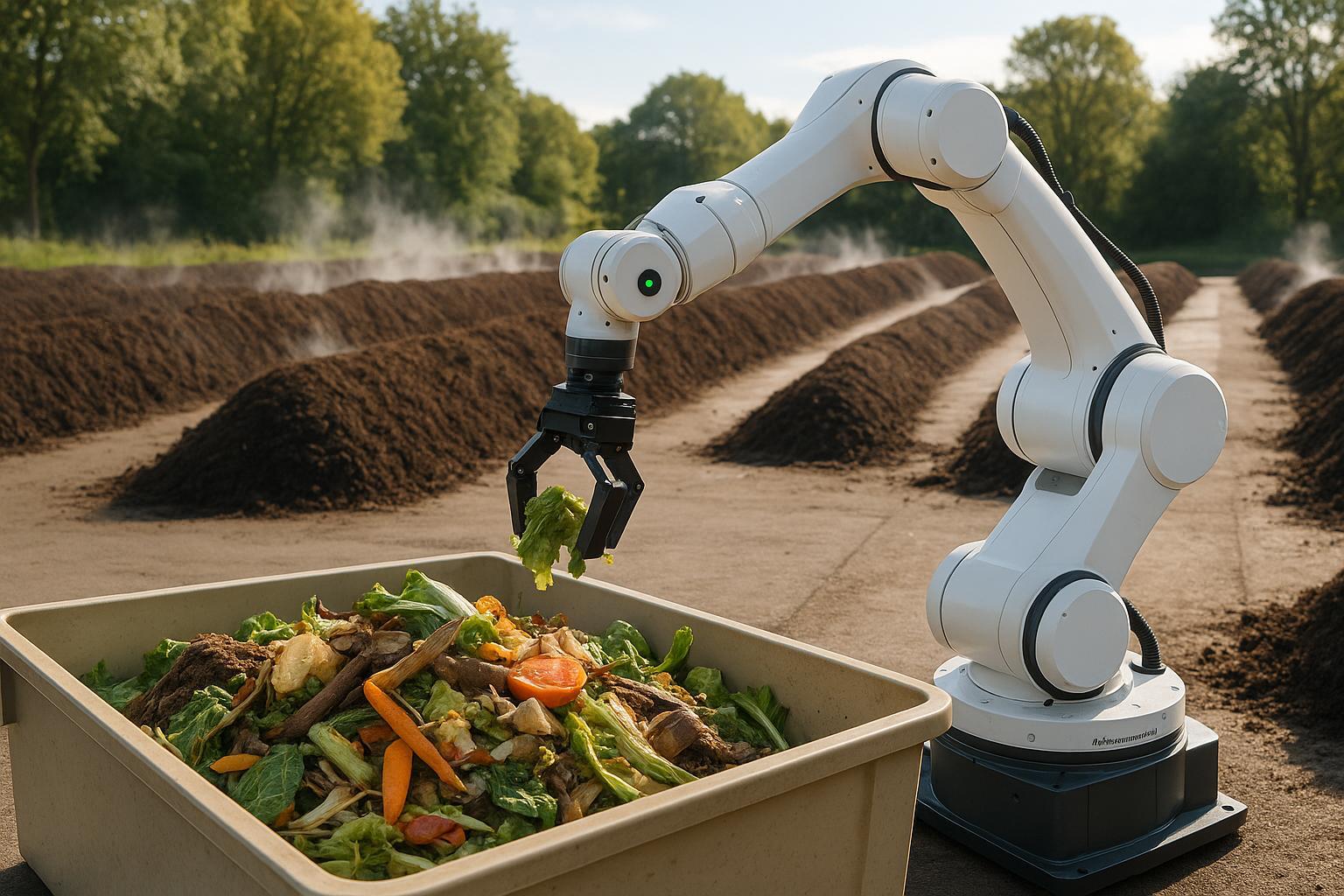
AI in Composting: Emission Control Insights
Explore how AI is revolutionizing composting by reducing emissions, enhancing sorting accuracy, and improving overall efficiency.
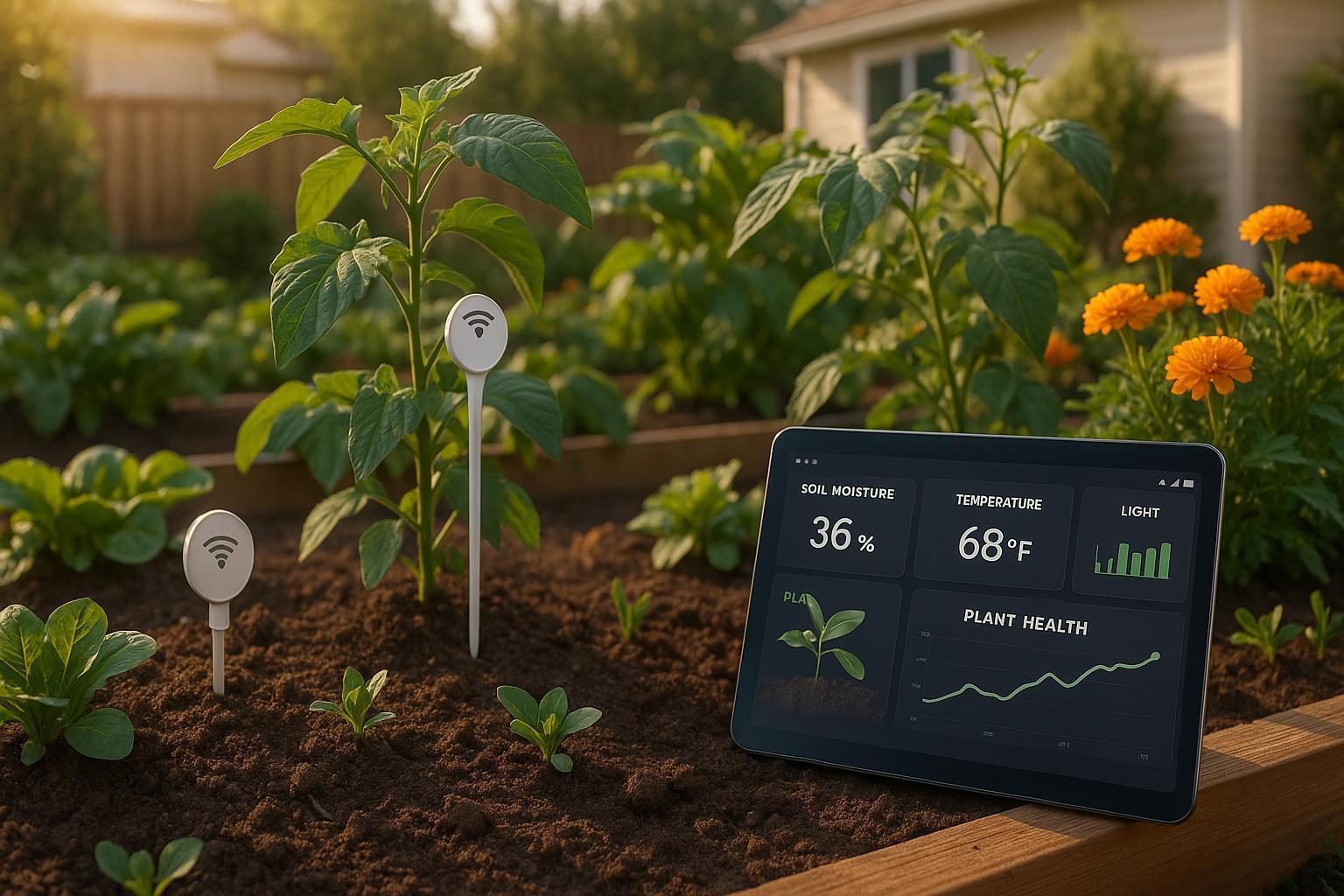
IoT Data Collection for Climate-Specific Gardening
Explore how IoT technology revolutionizes gardening by optimizing resource use, predicting diseases, and enhancing plant health for sustainable practices.
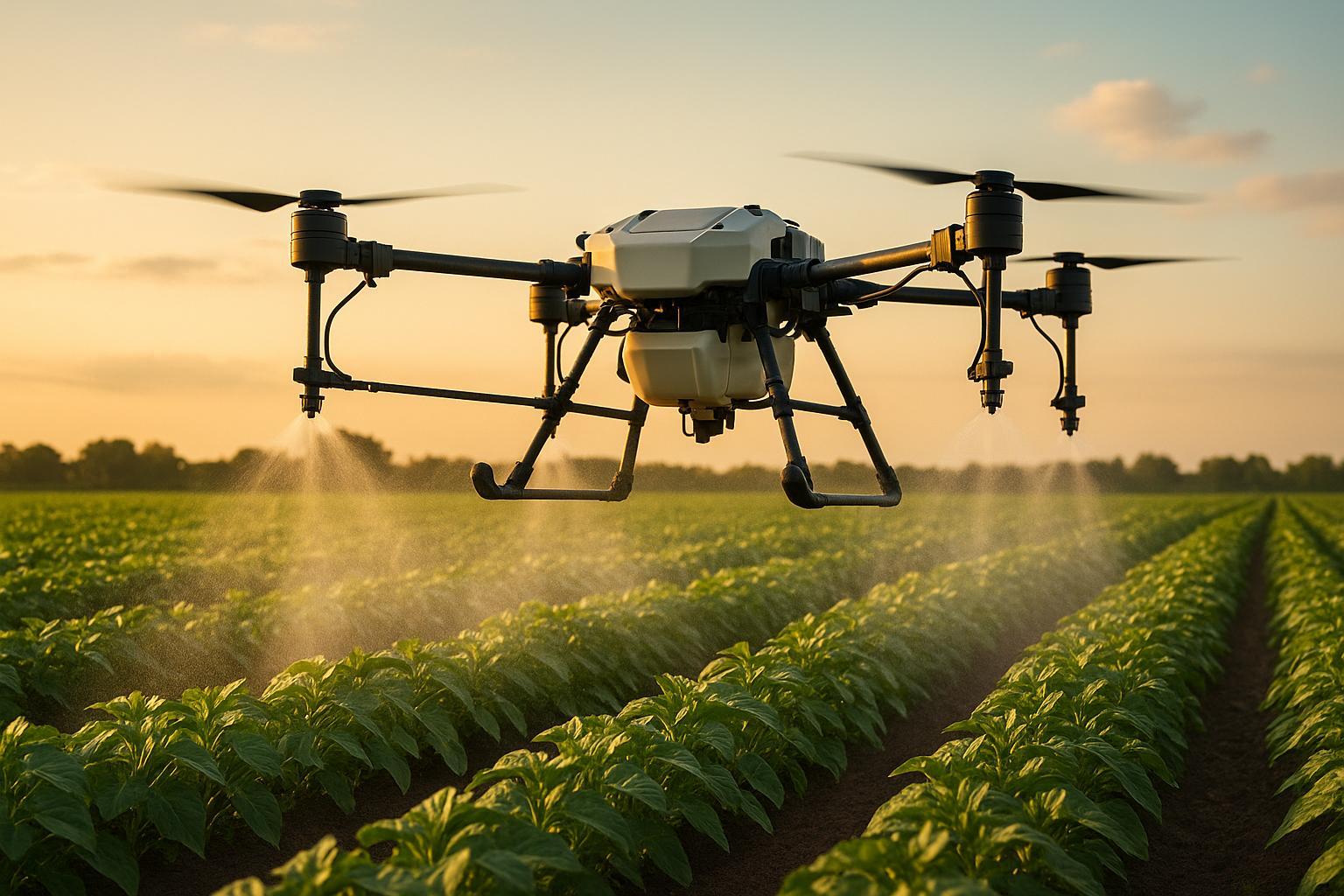
AI in Spray Coverage: How It Improves Accuracy
AI technology is revolutionizing agricultural spray coverage, enhancing precision while cutting costs and reducing environmental impact.
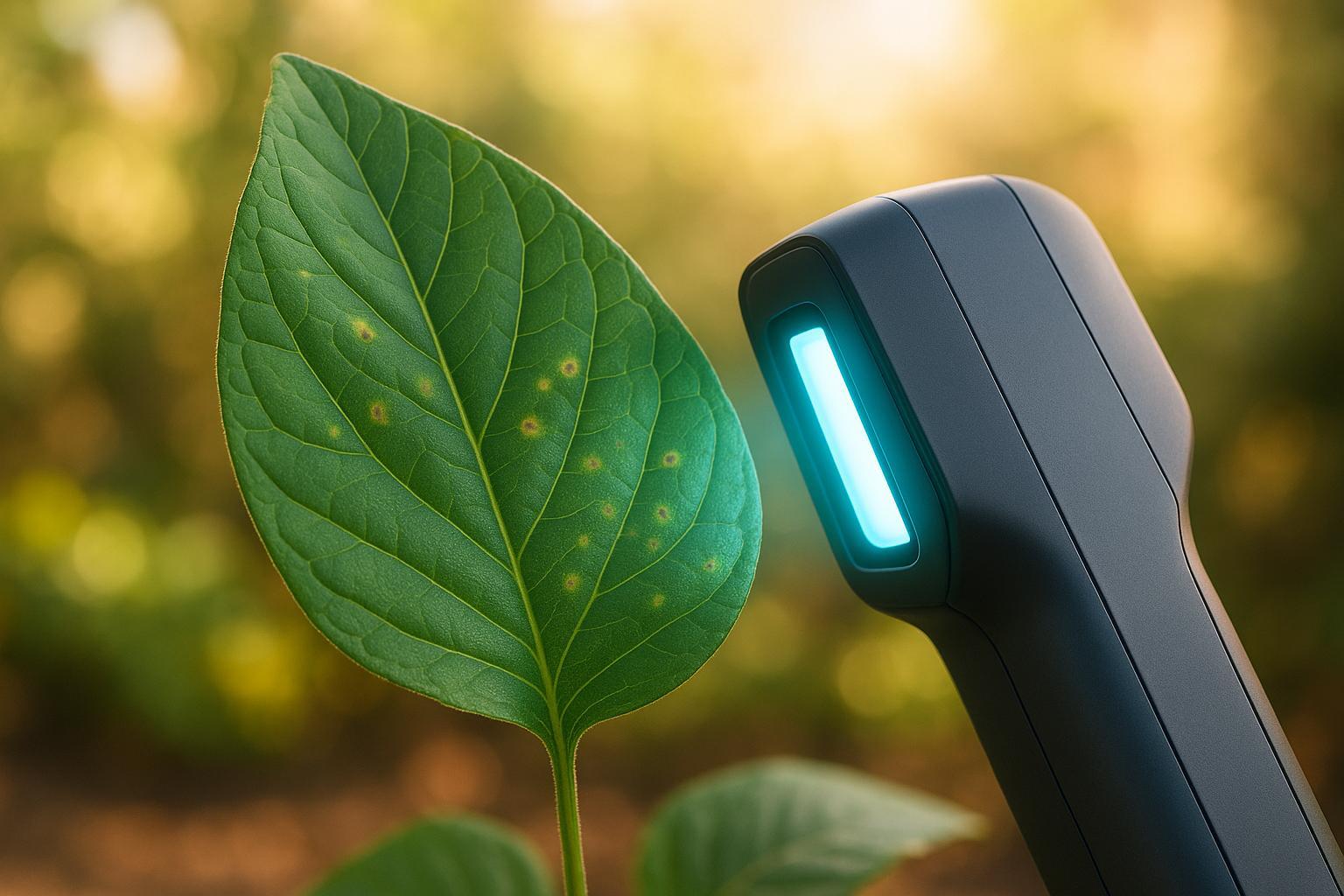
Optimizing Deep Learning for Plant Disease Detection
Explore how deep learning optimizes plant disease detection with advanced techniques for better accuracy, efficiency, and real-time monitoring.

How AI Apps Detect Garden Pests in Real Time
AI apps revolutionize pest management by providing instant identification and tailored solutions for garden pests, enhancing plant protection.
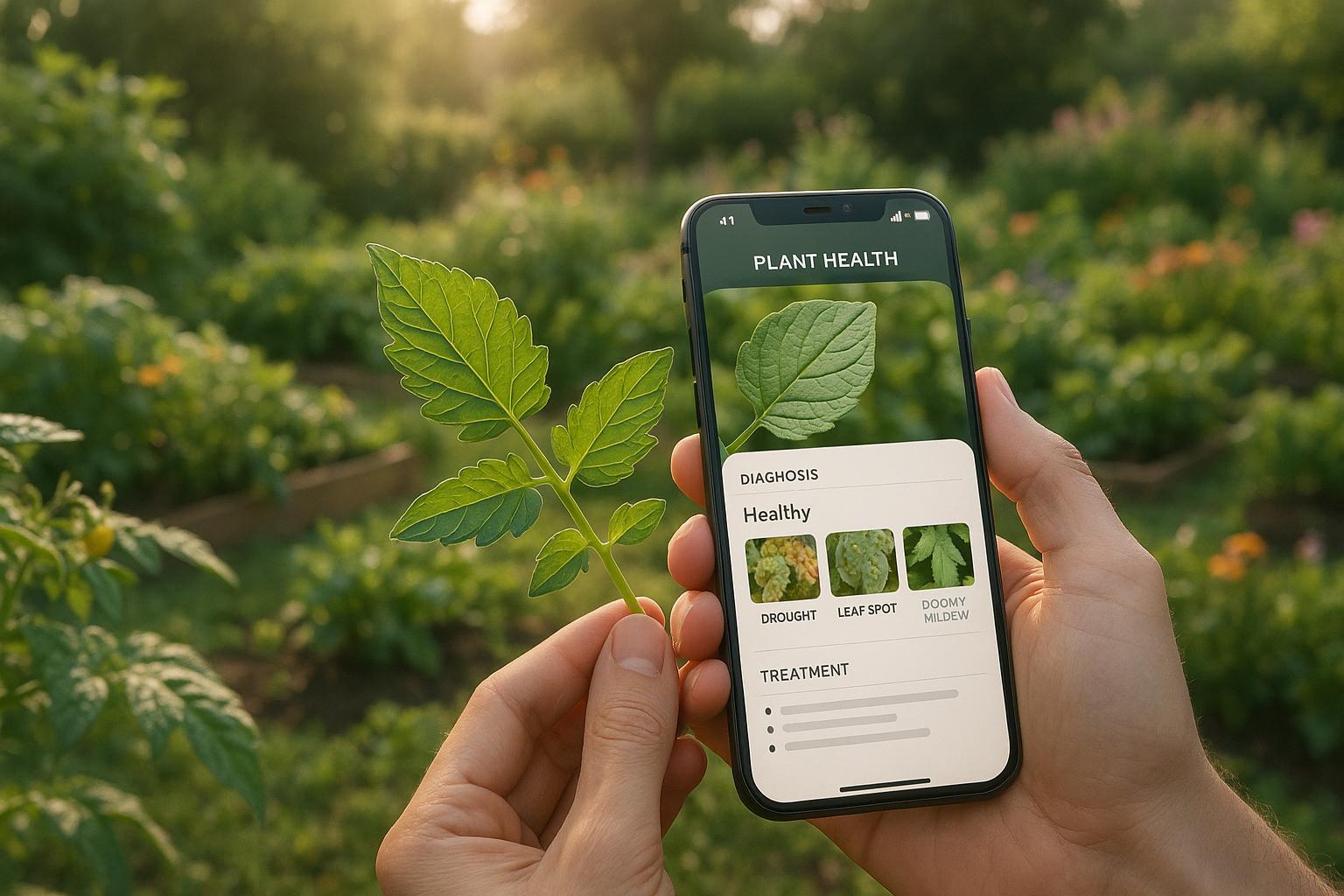
How AI Apps Predict Garden Diseases
AI gardening apps revolutionize plant care by enabling early disease detection, customized treatments, and proactive prevention strategies.